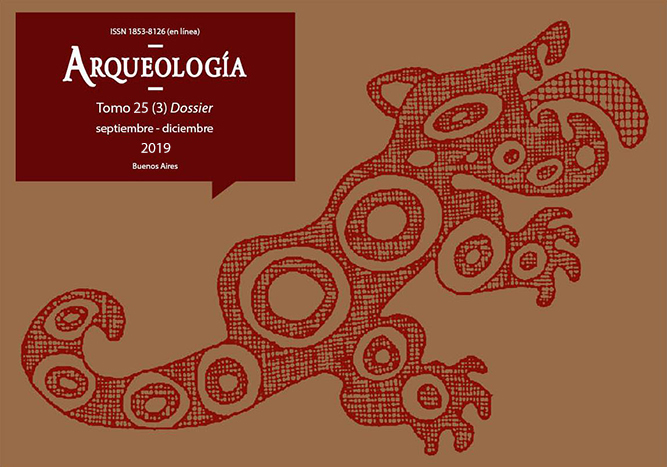Identificación de microrrestos botánicos en vasijas guaraníes de la cuenca del río Paraná (Argentina)
Palabras clave:
Alfarería guaraní, Cuenca del río Paraná, Fitolitos, Almidones, Recursos vegetales, Museo de La Plata
Resumen
Tradicionalmente, en la literatura arqueológica se ha considerado a la agricultura en pequeña escala como un componente central del modo de vida de las poblaciones guaraníes que ocuparon la cuenca del río de La Plata. Esta asociación se fundamentó en la información extraída de documentos históricos coloniales y de investigaciones etnográficas. A pesar de la importancia atribuida a la práctica agrícola en el contexto de las ocupaciones identificadas con la tradición guaraní son escasos los estudios sobre evidencias botánicas provenientes del registro arqueológico. En este trabajo se presentan los análisis de microrrestos silíceos y de almidón provenientes de vasijas cerámicas de la tradición guaraní de la cuenca del río Paraná almacenadas en el Depósito 25 de la División Arqueología del Museo de La Plata (Argentina). Se tomaron muestras de 14 piezas provenientes del Delta (sitios Río Paraná Miní y Arroyo Fredes) y del Alto río Paraná. Los resultados demostraron la presencia de microfósiles de sílice tales como los gaminoides, podostemoides y elementos dicotiledóneos, así como cuerpos de almidón, que permitieron identificar granos relacionados con Zea mays y Phaselous sp. Se observó, además, la relación entre algunos morfotipos y determinadas tipologías alfareras. En este sentido se destaca que los residuos orgánicos se encontraron preferentemente en vasijas asociadas con el almacenamiento, la fermentación y el servicio de bebidas.Descargas
La descarga de datos todavía no está disponible.
Publicado
2019-10-01
Cómo citar
Costa Angrizani, R., Colobig, M. de los M., & Zucol, A. F. (2019). Identificación de microrrestos botánicos en vasijas guaraníes de la cuenca del río Paraná (Argentina). Arqueología, 25(3), 37-57. https://doi.org/10.34096/arqueologia.t25.n3.7323
Sección
Artículos
Derechos de autor 2019 Arqueología

Esta obra está bajo licencia internacional Creative Commons Reconocimiento-NoComercial-CompartirIgual 4.0.
Los autores/as que publiquen en esta revista aceptan las siguientes condiciones:
- Los autores/as conservan los derechos de autor y ceden a la revista el derecho de la primera publicación, con el trabajo registrado mediante Licencia Creative Commons 4.0 Internacional (CC-BY-NC-SA), que permite a terceros utilizar lo publicado siempre que mencionen la autoría del trabajo y a la primera publicación en esta revista.
- Los autores/as pueden realizar otros acuerdos contractuales independientes y adicionales para la distribución no exclusiva de la versión del artículo publicado en esta revista (p.e. incluirlo en un repositorio institucional o publicarlo en un libro) siempre que indiquen claramente que el trabajo se publicó por primera vez en esta revista.
- Se permite y recomienda a los autores/as a publicar su trabajo en Internet (p.e. en sus sitios web personales o en depósitos institucionales), tanto antes como después de su publicación en esta revista, siempre y cuando proporcionen información bibliográfica que acredite, si procede, su publicación en ella. De esta manera, pueden favorecerse intercambios productivos y a una mayor y más rápida difusión del trabajo publicado (vea The Effect of Open Access).



.png)

(1)13.png)






1.jpg)
1.png)
1.jpg)


13.png)
1.png)


(1)1.png)









